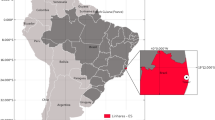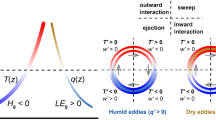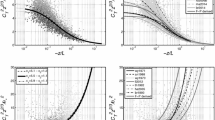Abstract
We discuss scalar similarities and dissimilarities based on analysis of the dissipation terms in the variance budget equations, considering the turbulent kinetic energy and the variances of temperature, specific humidity and specific CO\(_2\) content. For this purpose, 124 high-frequency sampled segments are selected from the Boundary Layer Late Afternoon and Sunset Turbulence experiment. The consequences of dissipation similarity in the variance transport are also discussed and quantified. The results show that, for the convective atmospheric surface layer, the non-dimensional dissipation terms can be expressed in the framework of Monin–Obukhov similarity theory and are independent of whether the variable is temperature or moisture. The scalar similarity in the dissipation term implies that the characteristic scales of the atmospheric surface layer can be estimated from the respective rate of variance dissipation, the characteristic scale of temperature, and the dissipation rate of temperature variance.







Similar content being viewed by others
References
Bloomfield P (2000) Fourier analysis of time series, 2nd edn. Wiley, Raleigh, 254 pp
Bluteau CE, Jones NL, Ivey GN (2011) Estimating turbulent kinetic energy dissipation using the inertial subrange method in environmental flows. Limnol Oceanogr Methods 9:302–321
Corrsin S (1951) On the spectrum of isotropic temperature fluctuations in an isotropic turbulence. J Appl Phys 22(4):469–473
de Arellano JVG, Duynkerke PG (1995) Atmospheric surface layer similarity theory applied to chemically reactive species. J Geophys Res 100:1397–1408
Detto M, Katul GG (2007) Simplified expressions for adjusting higher-order turbulent statistics obtained from open path gas analyzers. Boundary-Layer Meteorol 122:205–216
Dias NL, Brutsaert W (1996) Similarity of scalars under stable conditions. Boundary-Layer Meteorol 80(4):355–373
Dupuis H, Taylor PK, Weill A, Katsaros K (1997) Inertial dissipation method applied to derive turbulent fluxes over the ocean during the Surface of the Ocean, Fluxes and Interactions with the Atmosphere/Atlantic Stratocumulus Transition Experiment (SOFIA/ASTEX) and Structure des Echanges Mer-Atmosphere. J Geophys Res 102(C9):21115
Dyer AJ (1974) A review of flux-profile relationships. Boundary-Layer Meteorol 7(3):363–372
Edson JB, Fairall CW (1998) Similarity relationships in the marine atmospheric surface layer for terms in the TKE and scalar variance budgets*. J Atmos Sci 55(13):2311–2328
Edson JB, Fairall CW, Mestayer PG, Larsen SE (1991) A study of the inertial-dissipation method for computing air-sea fluxes. J Geophys Res 96(C6):10689
Fairall CW, Larsen SE (1986) Inertial-dissipation methods and turbulent fluxes at the air-ocean interface. Boundary-Layer Meteorol 34(3):287–301. doi:10.1007/BF00122383
Foken T (2006) 50 years of the Monin–Obukhov similarity theory. Boundary-Layer Meteorol 119(3):431–447
Foken T, Göockede M, Mauder M, Mahrt L, Amiro B, Munger W (2005) Post-field data quality control. Springer, Dordrecht
Foken T, Wimmer F, Mauder M, Thomas C, Liebethal C (2006) Some aspects of the energy balance closure problem. Atmos Chem Phys 6(2):3381–3402
Hartogensis OK, Bruin HARD (2005) Monin–Obukhov similarity functions of the structure parameter of temperature and turbulent kinetic energy dissipation rate in the stable boundary layer. Boundary-Layer Meteorol 116(2):253–276. doi:10.1007/s10546-004-2817-1
Hill RJ (1989) Implications of Monin–Obukhov similarity theory for scalar quantities. J Atmos Sci 46(14):2236–2244
Hill RJ (1997) Algorithms for obtaining atmospheric surface-layer fluxes from scintillation measurements. J Atmos Ocean Technol 14(3):456–467
Högström U (1996) Review of some basic characteristics of the atmospheric surface layer. Boundary-Layer Meteorol 78(3–4):215–246
Iwata T, Yoshikawa K, Higuchi Y, Yamashita T, Kato S, Ohtaki E (2005) The spectral density technique for the determination of CO\(_2\) flux over the ocean. Boundary-Layer Meteorol 117(3):511–523
Jensen DD, Nadeau DF, Hoch SW, Pardyjak ER (2016) Observations of near-surface heat-flux and temperature profiles through the early evening transition over contrasting surfaces. Boundary-Layer Meteorol 159(3):567–587
Kader BA (1992) Determination of turbulent momentum and heat fluxes by spectral methods. Boundary-Layer Meteorol 61(4):323–347
Kaimal JC, Gaynor JE (1983) The boulder atmospheric observatory. J Clim Appl Meteorol 22(5):863–880
Kaimal JCJ, Wyngaard JCJ, Izumi Y, Coté OR, Cote OR (1972) Spectral characteristics of surface-layer turbulence. Q J R Meteorol Soc 98(417):563–589
Katul GG, Hsieh CI (1999) A note on the flux-variance similarity relationships for heat and water vapour in the unstable atmospheric surface layer. Boundary-Layer Meteorol 90(2):327–338
Katul GG, Sempreviva AM, Cava D (2008) The temperature-humidity covariance in the marine surface layer: a one-dimensional analytical model. Boundary-Layer Meteorol 126(2):263–278
Kolmogorov AN (1941) Dissipation of energy in locally isotropic turbulence. Dokl Akad Nauk SSSR 32(1):16–18
Kooijmans LMJ, Hartogensis OK (2016) Surface-layer similarity functions for dissipation rate and structure parameters of temperature and humidity based on eleven field experiments. Boundary-Layer Meteorol 160(3):501–527
Lee X, Finnigan J, Paw UKT (2005) Coordinate systems and flux bias error. Springer, Dordrecht, pp 33–66
Li D, Bou-Zeid E (2011) Coherent structures and the dissimilarity of turbulent transport of momentum and scalars in the unstable atmospheric surface layer. Boundary-Layer Meteorol 140(2):243–262
Li M, Babel W, Tanaka K, Foken T (2013) Note on the application of planar-fit rotation for non-omnidirectional sonic anemometers. Atmos Meas Tech 6(2):221–229
Lothon M, Lohou F, Pino D, Couvreux F, Pardyjak ER, Reuder J, de Vilà-Guerau Arellano J, Durand P, Hartogensis O, Legain D, Augustin P, Gioli B, Faloona I, Yagüe C, Alexander DC, Angevine WM, Bargain E, Barrié J, Bazile E, Bezombes Y, Blay-Carreras E, van de Boer A, Boichard JL, Bourdon A, Butet A, Campistron B, de Coster O, Cuxart J, Dabas A, Darbieu C, Deboudt K, Delbarre H, Derrien S, Flament P, Fourmentin M, Garai A, Gibert F, Graf A, Groebner J, Guichard F, Jimenez Cortes Ma, Jonassen M, van den Kroonenberg A, Lenschow DH, Magliulo V, Martin S, Martinez D, Mastrorillo L, Moene aF, Molinos F, Moulin E, Pietersen HP, Piguet B, Pique E, Román-Cascón C, Rufin-Soler C, Saïd F, Sastre-Marugán M, Seity Y, Steeneveld GJ, Toscano P, Traullé O, Tzanos D, Wacker S, Wildmann N, Zaldei A (2014) The BLLAST field experiment: boundary-layer late afternoon and sunset turbulence. Atmos Chem Phys 14(7):10,789–10,852
Mahrt L (1999) Stratified atmospheric boundary layers. Boundary-Layer Meteorol 90(3):375–396
Nilsson E, Lothon M, Lohou F, Pardyjak E, Hartogensis O, Darbieu C (2016) Turbulence kinetic energy budget during the afternoon transition: part 2: a simple TKE model. Atmos Chem Phys 15(21):29,807–29,869
Norman M, Rutgersson A, Sørensen LL, Sahlée E (2012) Methods for estimating airsea fluxes of CO\(_2\) using high-frequency measurements. Boundary-Layer Meteorol 144(3):379–400
Ohtaki E (1985) On the similarity in atmospheric fluctuations of carbon dioxide, water vapor and temperature over vegetated fields. Boundary-Layer Meteorol 32(1):25–37
Pahlow M, Parlange MB, Port-Agel F (2001) On Monin–Obukhov similarity in the stable atmospheric boundary layer. Boundary-Layer Meteorol 99(2):225–248
Rannik Ü (1998) On the surface layer similarity at a complex forest site. J Geophys Res 103(D8):8685–8697
Rannik U, Peltola O, Mammarella I (2016) Random uncertainties of flux measurements by the eddy covariance technique. Atmos Meas Tech 9(10):5163–5181
Ruppert J, Thomas C, Foken T (2006) Scalar similarity for relaxed eddy accumulation methods. Boundary-Layer Meteorol 120(1):39–63
Sahlée E, Smedman AS, Rutgersson A, Högström U (2008) Spectra of CO\(_2\) and water vapour in the marine atmospheric surface layer. Boundary-Layer Meteorol 126(2):279–295
Sempreviva AM, Højstrup J (1998) Transport of temperature and humidity variance and covariance in the marine surface layer. Boundary-Layer Meteorol 87(2):233–253
Sjöblom A, Smedman AS (2004) Comparison between eddy-correlation and inertial dissipation methods in the marine atmospheric surface layer. Boundary-Layer Meteorol 110(2):141–164
Sørensen LL, Larsen SE (2010) Atmosphere surface fluxes of CO\(_2\) using spectral techniques. Boundary-Layer Meteorol 136(1):59–81
Sørensen LL, Jensen B, Glud RN, McGinnis DF, Sejr MK, Sievers J, Søgaard DH, Tison JL, Rysgaard S (2014) Parameterization of atmosphere surface exchange of CO\(_2\) over sea ice. Cryosphere 8(3):853–866
Stull RB (1988) An introduction to boundary layer meteorology. Springer, Dordrecht, 666 pp
van de Boer A, Moene AF, Graf A, Schüttemeyer D, Simmer C (2014) Detection of entrainment influences on surface-layer measurements and extension of Monin–Obukhov similarity theory. Boundary-Layer Meteorol 152(1):19–44
Wang L, Li D, Gao Z, Sun T, Guo X, Bou-Zeid E (2014) Turbulent transport of momentum and scalars above an urban canopy. Boundary-Layer Meteorol 150(3):485–511
Webb EK, Pearman GI, Leuning R (1980) Correction of flux measurements for density effects due to heat and water vapour transfer. Q J R Meteorol Soc 106(447):85–100
Williams CA, Scanlon TM, Albertson JD (2007) Influence of surface heterogeneity on scalar dissimilarity in the roughness sublayer. Boundary-Layer Meteorol 122(1):149–165
Willis GE, Deardorff JW (1976) On the use of Taylor’s translation hypothesis for diffusion in the mixed layer. Q J R Meteorol Soc 102(434):817–822
Yelland M, Taylor PK (1996) Wind stress measurements from the open ocean. J Phys Oceanogr 26(4):541–558
Acknowledgements
The authors thank the technicians at IAG-USP and at GFI-UiB and several colleagues for assistance, and particularly for the valuable comments and support of Luciano P. Pezzi, Leonardo Domingues, Pamela Dominutti, Line Baserud and Valerie Kumer. The helpful comments of two anonymous reviewers are greatly appreciated. This work was conducted through a scholarship by the International Cooperation Program CAPES/COFECUB at the University of Bergen, financed by CAPES Brazilian Federal Agency for Support and Evaluation of Graduate Education within the Ministry of Education of Brazil. The BLLAST field experiment was made possible thanks to the contribution of several institutions and funding sources: INSU-CNRS (Institut National des Sciences de l’Univers, Centre national de la Recherche Scientifique, LEFE-IDAO program), Météo-France, Observatoire Midi-Pyrénées (University of Toulouse), EUFAR (EUropean Facility for Airborne Research) and COST ES0802 (European Cooperation in Science and Technology). The field experiment would not have occurred without the contribution of all participating European and American research groups, which all have contributed significantly. The BLLAST field experiment was hosted by the instrumented site of Centre de Recherches Atmospheriques, Lannemezan, France (Observatoire Midi-Pyrénées, Laboratoire d’Aérologie). The BLLAST data are managed by SEDOO, from the Observatoire Midi-Pyrénées. The participation of the Meteorology Group of the Geophysical Institute, University of Bergen was facilitated by contributions of the Geophysical Institute and the Faculty of Mathematics and Natural Sciences under the “smådriftsmidler” scheme, a travel stipend by the Meltzer Foundation in Bergen, and the Short Term Scientific Mission (STSM) scheme within the COST Action ES0802 “Unmanned Aerial Vehicles in Atmospheric Research”.
Author information
Authors and Affiliations
Corresponding author
Electronic supplementary material
Below is the link to the electronic supplementary material.
Appendices
Appendix 1: Density Correction Applied for \(S_c\) and \(\sigma _c\)
While the density correction of Webb et al. (1980) is defined only for the covariances \(\overline{w'c'}\) and \(\overline{w'q'}\), it should also be extended to the spectra, as mentioned by Sahlée et al. (2008) who derived an alternative direct-conversion method, which performs a unit conversion directly on the high-frequency time series.
Here, we use the equations derived by Detto and Katul (2007) for the correction to the CO\(_2\) density variance, \({\overline{{\rho '_c}^2}}_{WPL}\), to correct the CO\(_2\) power spectrum, \(S_c\). The \({\overline{{\rho '_c}^2}}_{WPL}\) quantity can be expressed according to
where \(\mu ={m_a}/{m_q}\) is the ratio between the molecular mass of dry air (\(m_a\)) and the water vapour (\(m_q\)), and T is the air temperature. From the definition of standard deviation, the correction for the scalar standard deviation is \({\sigma _c}_{WPL}=\sqrt{{\overline{{\rho '_c}^2}}_{WPL}}\).
The scalar variance can also be interpreted as the integral of \(S_\chi \), and the covariance as the integral of the cospectrum \(Co_{\chi _1 , \chi _2}\). Therefore, the density correction for \(S_c\), for each frequency (n), is expressed as
Appendix 2: Method for Detection of the Inertial Subrange
Since it is crucial for the spectral method to accurately resolve the inertial subrange, we propose an iterative method to evaluate the variations of the independent constants \(\alpha \) and \(\beta \) defined in Eqs. 7 and 8 by keeping constant values for the dissipation rates within a frequency interval I. From the definition of the inertial subrange, both the dissipation rates and \(\alpha \), or \(\beta \), are constant and, therefore, the boundaries for I can be defined by evaluating the standard deviation calculated for \(\alpha \), or \(\beta \), in different regions of the spectra.
The spectra calculated from 18,000 data samples collected at 20 Hz are divided into 48 frequency blocks (as shown in Online Resource 1), of which the number of estimates per block is logarithmically distributed, similar to the ones proposed by Kaimal and Gaynor (1983). For each block-centred frequency, \(n^*\), the average power spectrum, \(\overline{S}(n^*)\), and the dissipation rate of TKE, \(\epsilon ^*(\overline{S_w}(n^*),n^*)\), are calculated using the following equation derived from the Kolmogorov power law,
The iteration among the blocks consists of a loop starting from the centred frequency block \(n^*=0.0922\) Hz (index 22 in Online Resource 1) and moving the interval I towards the higher frequencies, one block per iteration, up to \(n^*=4.5244\) Hz (index 44). For this method, we suggest a window size for the interval I that includes nine consecutive blocks.
For each iteration, \(\alpha \) is estimated for the nine \(n^*\) within interval I, keeping \(\epsilon ^*\) as a constant equal to the one corresponding to the fifth block from interval I (i.e. the block in the middle of interval I). Finally, the standard deviation of \(\alpha \), \(\sigma _\alpha \), is calculated for each I.
The inertial subrange is then defined as the interval I that has the smallest \(\sigma _\alpha \) after completing the iteration. If the smallest \(\sigma _\alpha \) is greater than 0.07 (i.e. \(10\%\) of \(\alpha \)), we consider that the method cannot define an inertial subrange. The \(\epsilon \) for the corresponding 30-min segment is then estimated according to the discussion in Sect. 2.4.
A similar procedure is carried out for the estimation of interval I in the power spectra of \(\theta \), q, and c. Since \(\epsilon \) is now known, the following Eq. 22 is applied in an analogous way as described before, but using \(\beta \) instead of \(\alpha \),
Rights and permissions
About this article
Cite this article
Hackerott, J.A., Bakhoday Paskyabi, M., Reuder, J. et al. A Surface-Layer Study of the Transport and Dissipation of Turbulent Kinetic Energy and the Variances of Temperature, Humidity and CO\(_2\) . Boundary-Layer Meteorol 165, 211–231 (2017). https://doi.org/10.1007/s10546-017-0271-0
Received:
Accepted:
Published:
Issue Date:
DOI: https://doi.org/10.1007/s10546-017-0271-0




